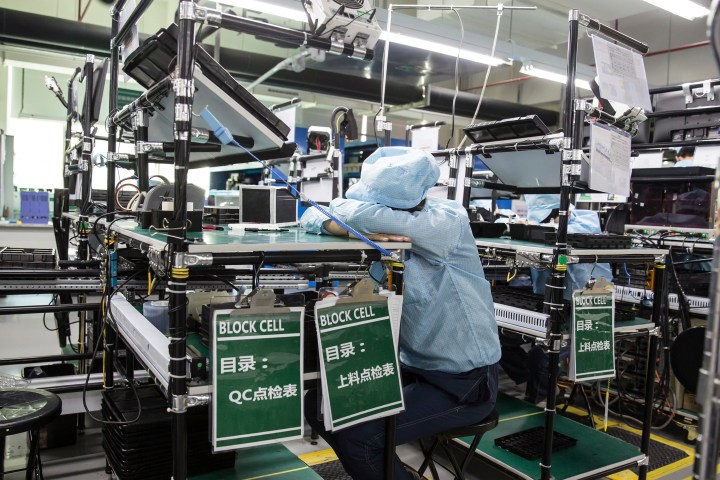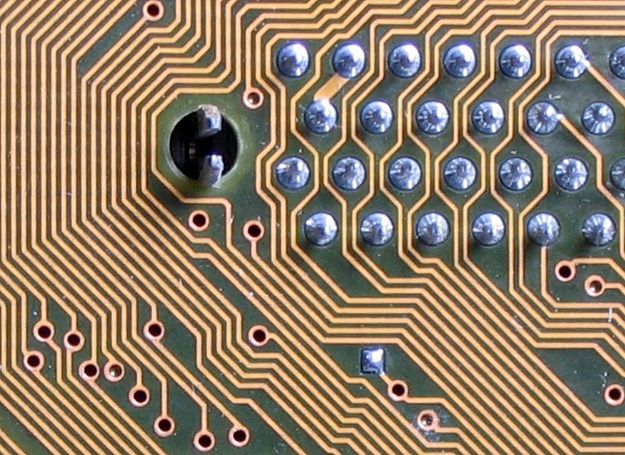That’s heavier than all of the adults in Europe combined, and this waste isn’t the same as the trillions of pounds of trash generated the world. E-waste contains a slew of harmful chemicals and materials, like mercury, which the UN says accounts for about 110,000 pounds of undocumented waste every year.
I sat down with a few experts in the field of electronics design, sustainability, and repair to figure out why we have such a big e-waste problem — and more importantly, what we can do to solve it.
But to understand our e-waste problem, we have to look past the waste itself.
Device life cycle, and a circular economy

If you pay attention to big tech events, you’ve undoubtedly heard about the “circular economy.” If you’re unfamiliar, the idea is simple enough: Instead of having an end of life for devices, they’re reintroduced, recycled, or reused to keep the life cycle going. You know, like a circle.
That’s something Michelle Chuaprasert, senior director of innovation and sustainability at Intel, is focused on. The idea of a circular economy is great in theory — just keep using devices that are already around — but it has a big problem. A lot of people either don’t want to get rid of their old devices, or they don’t know how.
“How do we facilitate someone handing down their PC at first life to someone else,” Chuaprasert asked when I talked with her. “The options are there. I think it’s a matter of how do we all motivate each other, right, to take advantage of [recycling programs] … or donate in whichever way is easy for us.”
There are a growing number of ways to either recycle of resell your old devices, even if they aren’t perfect. Best Buy and Staples offer in-store recycling programs, and major device manufacturers like Apple offer trade-in programs. Sites like BackMarket also offer a secondhand marketplace tailored for electronics. And Intel says an increasing number of people are buying secondhand since the coronavirus pandemic emerged.
Melissa Gregg is a senior principal engineer at Intel, who headed up the Intel EVO line before moving on to aid efforts to create more sustainable designs. Gregg told me that the pandemic offered “an opportunity to have that conversation, perhaps even for the first time, if whether people always need a new PC.”
It’s no secret that the demand for computers grew immensely during 2020, as the exodus from the office pushed workers into their homes and schools transitioned to a remote learning model. Add on top of that the chip shortage, and it was difficult for a lot of people to buy a new PC. In some ways, it still is.
The UN says only 17.4% of e-waste was collected and recycled in 2019. And the U.S. is one of the worst countries in the world when it comes to recycling.
The positive outcome, according to Intel, is that hopeful buyers started seeking out secondhand options. “For all of those other people who still need computers, recirculating them, and having access to platforms that make that easy for people to pass on their devices, to me, is a really positive outcome of a pretty bad situation,” Gregg said.
So, problem solved, right? Everyone trades in or recycles their old devices, we don’t dump or burn any more toxic e-waste, and round and round the circle goes.
But it’s not working.
Best Buy has offered recycling for the past 12 years, and although the company says it has recycled 2 billion pounds of electronics since 2009, that’s only a microscopic fraction of the total e-waste the world produces in a single year. In total, the UN says only 17.4% of e-waste was collected and recycled in 2019. And the U.S. is one of the worst countries in the world when it comes to recycling.
Owners of devices have a responsibility to ensure that those devices don’t end up in a landfill. But that only addresses a small part of the problem with how electronics impact the environment.
Billowing smog
Manufacturing. If you’re concerned about the impact e-waste has on the environment, manufacturing should terrify you. It’s true that a circular economy is good for everyone, but manufacturing is where “the big, ugly stuff is done,” according to Gay Gordon-Byrne, executive director of The Repair Association.
Compared to usage, manufacturing accounts for a much more significant portion of a device’s carbon footprint. Microsoft says that around 78% of a Surface device’s carbon footprint comes from manufacturing. A report from 2018 says that between 85% and 95% of annual carbon emissions from phones is due to manufacturing.
It’s the dirty secret of the electronics that power our world today. Recycling your devices helps, and voluntary ecolabels like EPEAT and Energy Star give manufacturers a goal post for designing more energy-efficient devices. But the fact of the matter is, when you get rid of one device, the manufacturer is ready to make a new one.

“That creates two big problems,” according to Gordon-Byrne. “One is you’ve now got an e-waste problem you didn’t have, and on the other side, you also have a manufacturing problem where really, the big, ugly stuff is done. You know, all the mining, all the terrible worker experiences, all of the pollution. That’s actually all manufacturing.”
This isn’t something the Microsofts and Intels of the world have shied away from. It’s easy and justified to point the finger at manufacturers, but that’s not a solution. Given our reliance on devices today, we can’t just stop making them — but manufacturers can take steps to reduce their environmental impact.
The idea is dematerialization, which Chuaprasert says is a “really big” deal. Take a motherboard, for example. “The motherboard itself inside the PC is one of the higher carbon footprint areas,” Chuaprasert said. “You can make a really big difference if you can shrink the motherboard.”
Chuaprasert even pointed to circuit board cutting. Often, devices come with motherboards cut in a precise way to fit a particular form factor, but taking cutting out of the picture can make for more efficient manufacturing. “Just having more rectangular shapes instead of cutouts goes a long way for reducing the carbon footprint.”

This is something Intel is working with device manufacturers to accomplish, and ecolabels like EPEAT offer insight into the advancements designers are making. My favorite laptop, the recent Dell XPS 13 2-in-1, received an EPEAT Gold label on the back of energy efficiency, packaging, materials, and even labor practices. If you want to buy a new device and you care about its climate and social impact, you should reference EPEAT and Energy Star.
Although you should use these labels, they don’t always tell the full story. The most recent MacBook Pro, for example, earned a Gold rating from EPEAT, but only scored one out of four in the product longevity category. That’s because it’s not repairable or upgradeable, and Apple doesn’t offer any repair guidance.
With some devices barred from easy, cost-effective repairs, it doesn’t matter how the device was built. If you have a broken device and you can’t repair it, you’ll buy a new one, and that’s the crux of the problem.
These are “hard economic facts,” according to Gordon-Byrne. “Every time you throw [away] a PC or a laptop or something … they get another order.”
The right to repair
The idea of right to repair has been buzzing over the last year. Under shareholder pressure, Microsoft bent the knee and committed to increased repair options for its devices by the end of 2022. And in July, the Federal Trade Commission voted unanimously to enforce an order that ramps up law enforcement against illegal repair restrictions.
The movement stems from a 2011 Massachusetts law, the Motor Vehicle Owners Right to Repair Act. This law requires carmakers to provide all of the information necessary to diagnose and repair a vehicle, which opens the doors to third-party repair shops and even owner repairs.
The electronics industry is rife with examples of products that are designed not to be repaired.
It’s a foundational piece of legislation for the world today, but it only applies to cars. The right to repair movement is all about enacting new legislation that covers everything else — from MacBooks to tractors. “We’ve got a lot of experience now that says that works great for cars. It should work for everything, but the legislation itself is just for cars,” Gordon-Byrne said.
The electronics industry is rife with examples of products that are designed not to be repaired. The Nintendo Switch, for example, use tri-point screws instead of Phillips head. And anecdotally, the screws seem to use a soft metal, easily stripping when I went to do a Joy-Con shell swap. The “warranty void if removed stickers” warnings you often see usually aren’t true, either. The Magnuson-Moss Warranty Act — passed in 1975 — was designed to protect against these kinds of deceptive warranties.

Right to repair is good for consumers, but it has environmental implications, too. For example, iFixIt — a third-party company that offers resources and tools to repair electronics — rates the 2019 MacBook Pro as one of the least repairable options on the market (a trend with other Apple devices iFixIt has ranked). A big reason why is that this laptop, along with many others, has components soldered to the motherboard.
As we’ve already covered, these boards represent a big portion of a device’s carbon footprint. And the most efficient way to repair these devices isn’t to resolder components — it’s to replace the board entirely, ship back the broken one for repair, and reintroduce that in another device. That’s not to mention the problems independent repair shops can have resoldering components without access to schematics.
Apple and others have taken steps to make repairs easier, but Gordon-Byrne suggests that it’s not enough. “I’d rather have legislation,” Gordon-Byrne said. “I think that they need to be told that they need to do these things. Because if we wait for them to do it out of their good graces, we know that that’s not in their financial best interest, so they’re not going to do it.”
The idea of a circular economy works if someone wants to get rid of one device and buy another, but it doesn’t account for those who like the devices they already own. That’s where right to repair comes in, giving owners more options to repair their devices instead of feeding the manufacturing machine or contributing to another pile of e-waste.
The right to repair movement is making headway. At the time of publication, 25 states have right to repair laws on the books, and another 14 have introduced bills in the past. But Gordon-Byrne says device makers are still “biting away around the edges.”
“The really big improvement, the one they don’t want to make, is letting people fix their stuff,” she added.
Big problems, big solutions

Recycling isn’t enough to solve our e-waste problem because e-waste isn’t the only problem. It’s one solution for one problem, but e-waste represents many other issues: Our reliance on devices and their supply chains, closed repair ecosystems, and the environmental impact of manufacturing.
“There’s a bigger story to tell about how we need to think about our reliance on devices and the ability to repair them, or trade them, or have them continue to circulate, so we do have autonomy from the instability of supply chains,” Gregg said.
Recycling is a positive step, one that consumers woefully underuse. But to address the increasing issues of e-waste and how electronics impact the environment, we need more sustainable device designs, more energy-efficient technology, and critically, the right to repair. Consumers play a role, but manufacturers do, too. And in this case, they need to lead the charge.
Chuaprasert says part of the problem is awareness. “We don’t always know to look, and I think that’s one area we can all work on, about increasing that awareness of what we can do.”
How you can get involved
So, what can you do? For devices you own, make sure to recycle or resell them — and consider buying secondhand instead of picking up the latest model. In addition, take advantage of ecolabels like EPEAT and Energy Star to help guide your purchasing decisions, and get involved in the right to repair movement. Gordon-Byrne offered an easy way to do that: “To complain effectively, you’ve got to complain to your legislators.”
All of those steps help, but manufacturers need to jump on board by designing more sustainable and repairable devices. Intel is helping manufacturers do that now, but that help only reaches so far.
Gregg summed it up nicely: “System recommendations, design, and working on dematerialization — it only works in an ecosystem and a business model that sees value in longevity.”
Editors' Recommendations
- Intel isn’t giving up on GPUs yet
- Is Apple’s Mac Mini M2 any good? Here’s what reviews say
- Here’s why people are saying two-factor authentication isn’t perfect
- Intel isn’t at Computex, and that could kill Arc Alchemist
- Apple’s Mac Studio isn’t modular — and that’s a good thing




